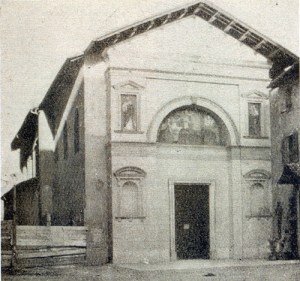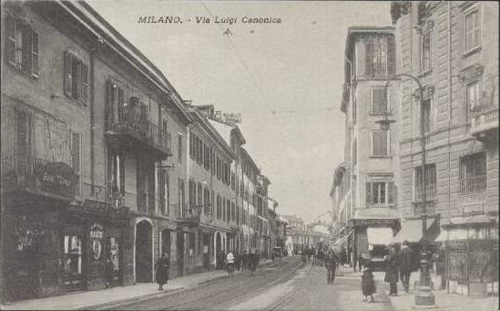Milano da conoscere - Le Piazze, le vie e la storia
Milan to know - The Squares, the streets and the history
 Il Borgh di Scigulatt - Borgo degli Ortolani
Il Borgh di Scigulatt - Borgo degli Ortolani
La storia di questo borgo è molto vecchia, infatti inizia verso la metà del IV secolo, e parte anche da molto lontano, da una bellisssima cittadina sulla Loira, Tours… da li arrivò il vescovo Martino nel 356 che a seguito di “incomprensioni” nella chiesa cattolica fu costretto a trovare un luogo dove ritirarsi a meditare.
Martino scelse un luogo in mezzo ad un bosco (in latino nemus) dove fondare un monastero; monastero dove lo stesso Ambrogio era solito ritirarsi, quando divenne vescovo di Milano pochi anni dopo (nel 374) a seguito della morte del suo precedessore, l’ariano Aussenzio.
E fu proprio a causa del vescovo Aussenzio che nel 358 Martino (non ancora santo…) dovette abbandonare Milano e il suo convento. Ambrogio fondò anche una chiesa, attigua al monastero dedicata a Santa Maria dell’Annuciazione.

Mappa del Borgo
La chiesa e il convento subirono nel corso dei secoli molte disavventure, fino alla sconsacrazione della chiesa avvenuta alla fine del 1700, quando fu istituita la Repubblica Cisalpina (1797).

Sant’Ambrogio ad nemus - Waypoint #1
Il monastero divenne, grazie all’impegno di Giovanna Lomeni e all’interessamento della contessa Ciceri Visconti, la prima sede dell’ospedale Fatebenesorelle, che com’è noto, venne successivamente spostato nel corso di Porta Nuova, dove attualmente è ubicata la sede dell’Azienda Ospedaliera Fatebenefratelli e Oftalmico.
Il Borgo degli Ortolani si sviluppava praticamente lungo tutta l’attuale via Luigi Canonica (architetto svizzero, 1762-1844) e il suo naturale proseguimento, via Piero della Francesca (pittore, 1415-1492), che fino alla seconda metà degli anni ’20 (del XX secolo) manteneva il toponimo di via Canonica.

Via Canonica. Foto d'epoca
Le molte risorse idriche della zona, il Nirone insieme a varie rogge e fontanili, furono certamente uno dei motivi principali per cui si sviluppò lungo la strada postale per Varese (via Canonica, appunto) una serie di cascine, i cui prodotti (frutta, ortaggi, verdure) venivano coltivati in abbondanza, raccolti e venduti dando così origine al nome del borgo, che in milanese sarebbe in realtà borgh di scigulatt, cioè il borgo dei produttori di cipolle, ma che per “estensione” del concetto divenne ufficialmente il “borgo degli ortolani”.
Il cache è posizionato in un piccolo parco giochi che è praticamente nel "baricentro" del Borgo all'angolo tra Via Canonica e Via Cesariano
Il cache
Un piccolo magnetico.. che non vi farà piangere!!!
 Il Borgh di Scigulatt - Borgh of the Gardeners
Il Borgh di Scigulatt - Borgh of the Gardeners
The history of this village is very old, in fact it begins around the middle of the fourth century, and also starts from a very beautiful town on the Loire, Tours ... from there came the bishop Martino in 356 that following "misunderstanding" in the Catholic church was forced to find a place to retreat to meditate.
Martino chose a place in the middle of a forest (in Latin nemus) where he founded a monastery; monastery where Ambrogio himself used to retire, when he became bishop of Milan a few years later (in 374) following the death of his predecessor, the Arian Aussentius.
And it was precisely because of the bishop Aussentius that in 358 Martino (not yet a saint ...) had to leave Milan and his convent. Ambrogio also founded a church, adjacent to the monastery dedicated to Santa Maria dell'Annuciazione.

Map of Borgo
Over the centuries, the church and the convent suffered many misadventures, until the church was deconsecrated at the end of the 18th century, when the Cisalpine Republic was established (1797).

Sant’Ambrogio ad nemus - Waypoint #1
The monastery became, thanks to the commitment of Giovanna Lomeni and the interest of Countess Ciceri Visconti, the first seat of the Fatebenesorelle hospital, which as it is known, was subsequently moved in the course of Porta Nuova, where is currently located 'Fatebenefratelli and Ophthalmic Hospital.
The Borgo degli Ortolani developed practically along the entire via Luigi Canonica (Swiss architect, 1762-1844) and its natural continuation, via Piero della Francesca (painter, 1415-1492), which until the second half of the 1920s (of the twentieth century) maintained the toponym of via Canonica.

Canonica Street. Old photo
The many water resources of the area, the Nirone along with various irrigation ditches and fountains, were certainly one of the main reasons for which a series of farms developed along the postal road to Varese (via Canonica), whose products (fruit, vegetables) , vegetables) were grown in abundance, collected and sold thus giving rise to the name of the village, which in Milan would actually be borgh of scigulatt, that is the village of onions producers, but that by "extension" of the concept officially became the "village of the gardeners ".
The cache is located in a small playground that is practically in the "barycentre" of the village on the corner between Via Canonica and Via Cesariano
The cache
A small magnetic .. that will not make you cry !!!